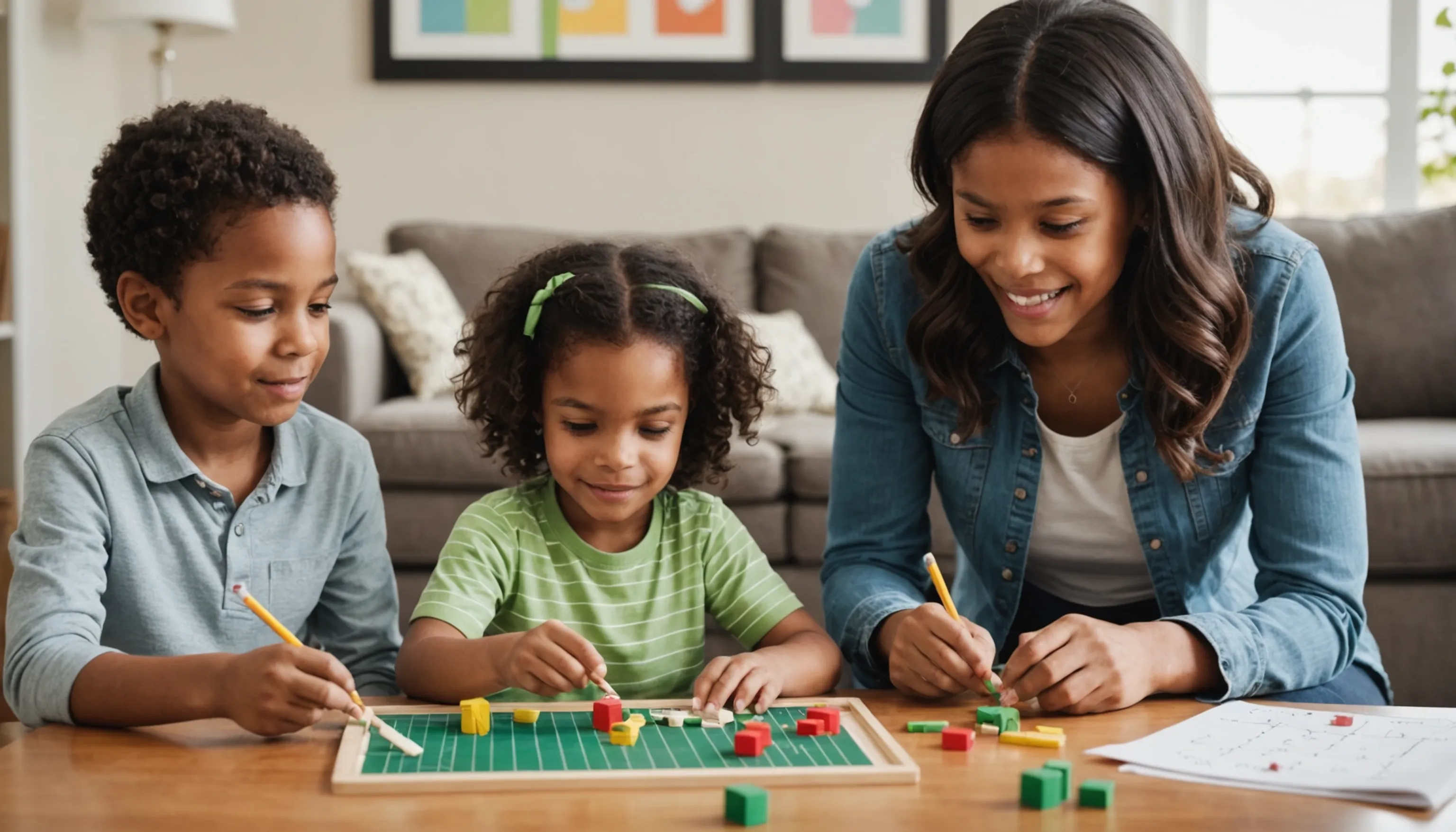Fun Math Activities for Home Schooling
 HvWHenry van Wagenberg
HvWHenry van Wagenberg
Fun Math Activities for Home Schooling
Engaging in fun math activities can significantly enhance the learning experience for students at home. Parents and teachers can introduce a variety of activities that make math enjoyable and practical. For instance, using everyday objects like building blocks to teach addition and subtraction can spark interest.
Another great idea is to incorporate math games into family game nights. Board games that involve counting or strategy can reinforce mathematical concepts. Additionally, creating math scavenger hunts around the house encourages problem-solving and critical thinking skills while keeping the learning process active and fun.
Interactive Online Math Games
Interactive online math games are an excellent way to make learning math exciting for students at home. These games combine fun and education, allowing teenagers to practice their math skills in an engaging environment. Various websites and platforms offer games tailored to different math concepts, making it easy to find something suitable for every learner.
Some popular options include:
- Kahoot! - A game-based learning platform that allows teachers and parents to create quizzes and challenges that can be played live or at the student’s own pace.
- Prodigy Math - An engaging role-playing game that covers a wide range of math topics, allowing students to practice skills while embarking on an adventure.
- Math Playground - Offers a variety of games and puzzles that focus on different math skills, from basic arithmetic to more advanced concepts like fractions and geometry.
These interactive games not only help in reinforcing math concepts but also promote critical thinking and problem-solving skills. Additionally, many of these platforms provide instant feedback, allowing students to learn from their mistakes and track their progress over time.
Incorporating interactive online math games into the homeschooling routine can lead to improved motivation and a positive attitude toward learning math, making it a valuable resource for both parents and educators.
Hands-On Math Projects
Hands-on math projects provide a tactile and engaging way for students to grasp mathematical concepts. These projects can be adapted to various age levels and can be integrated into home schooling curricula effectively. By combining math with creativity and real-world applications, students can see the relevance of math in their everyday lives.
One popular hands-on project is creating a scaled model of a building or a landscape. Students can use measuring tools to determine the dimensions and then apply their knowledge of ratios and proportions to create a model that reflects those measurements accurately. This project not only teaches geometry but also enhances spatial awareness.
Another fun project is organizing a math scavenger hunt. Parents can create a list of math-related challenges that require students to solve problems or find items around the house related to math concepts, such as shapes, measurements, or patterns. This encourages critical thinking and reinforces lessons learned.
Additionally, incorporating crafts into math lessons can be highly beneficial. For instance, students can create graph paper art, where they design a picture using grid squares. This activity reinforces concepts of area and perimeter while allowing for creativity.
Overall, hands-on math projects foster a deeper understanding of mathematical principles, promote teamwork, and make learning a more enjoyable experience for students.

Math Puzzles and Brain Teasers
Math puzzles and brain teasers are fantastic tools for enhancing problem-solving skills and critical thinking in students. These activities not only make math fun but also encourage logical reasoning and creativity. Incorporating puzzles into your homeschooling routine can stimulate your teenager's mind while providing a break from traditional math exercises.
One popular type of puzzle is the logic puzzle, where students must use deductive reasoning to solve a problem. For example, a classic logic puzzle might involve figuring out who lives in which house based on a set of clues. These puzzles can help develop analytical skills that are essential in mathematics.
Another engaging option is number puzzles, like Sudoku or KenKen. These games challenge students to fill a grid with numbers while following specific rules, promoting number sense and strategic thinking. They can be tailored to different skill levels, making them accessible for all learners.
Additionally, consider introducing math riddles that require creative thinking. For instance, riddles that involve wordplay and require mathematical reasoning can be both entertaining and educational.
By regularly incorporating math puzzles and brain teasers into the curriculum, parents can help students develop a positive attitude toward math. These activities can also serve as a great way to reinforce concepts while promoting a love for learning and exploration.
Incorporating Math into Daily Life
Incorporating math into daily life can make learning more relevant and practical for students. Parents and teachers can demonstrate math concepts through everyday activities. For instance, cooking and baking require measurements, ratios, and conversions, making it an excellent opportunity to practice fractions and multiplication.
Shopping trips can also be a fun way to teach budgeting and percentages. Ask your teenager to calculate discounts or compare prices while at the store. Additionally, DIY home projects, like measuring for furniture or creating a garden layout, can reinforce geometry skills. Making math a part of daily routines helps students see its value and application.
Cooking and Baking with Math
Cooking and baking with math offers a delicious and practical way to engage students in mathematical concepts. When preparing meals or baked goods, various math skills come into play, including measurement, fractions, and even geometry. By integrating math into these culinary activities, parents can help teenagers see the real-world applications of their math lessons.
For instance, measuring ingredients requires understanding units of measurement such as cups, tablespoons, and ounces. Students can practice converting measurements, which reinforces their knowledge of fractions and decimals. If a recipe calls for 1/2 cup of sugar and you want to double it, they can calculate that they need 1 cup—an excellent exercise in multiplication.
Additionally, baking often involves following a sequence of steps, allowing students to practice their skills in ordering and organizing information. They can also learn about ratios by adjusting recipes to serve more or fewer people. For example, if a recipe serves four and you need to serve eight, they can calculate the necessary ingredient quantities.
Moreover, cooking can involve geometry when cutting ingredients into specific shapes or sizes. For instance, when making pizza, students can learn about area by calculating the size of the pizza based on its diameter.
Overall, cooking and baking provide a fun, hands-on way to reinforce math skills while creating enjoyable meals and treats. This practical application can lead to increased interest and understanding of mathematics in everyday life.

Shopping: Budgeting and Discounts
Shopping: budgeting and discounts can be an excellent way to teach teenagers essential math skills while also preparing them for real-life financial responsibilities. By involving students in the shopping process, parents can help them understand how to manage money, calculate expenses, and make informed purchasing decisions.
One effective approach is to create a shopping budget together. Parents can set a specific amount of money for a shopping trip and involve their teens in planning how to allocate that budget. This exercise helps students practice addition and subtraction while considering the cost of items they want to purchase.
As they shop, encourage students to compare prices of similar items. This not only reinforces their skills in division and comparison but also teaches them about making cost-effective choices. Additionally, discussing discounts can provide valuable lessons in percentages. For example, if an item is originally priced at $50 and is on sale for 20% off, students can calculate the sale price by determining 20% of $50 and subtracting that from the original price.
Moreover, parents can encourage teens to look for coupons or promotional deals, reinforcing the concept of savings and financial planning. By analyzing the total cost after applying discounts, students gain practice in basic arithmetic and learn the importance of budgeting in everyday life.
Overall, incorporating shopping into math lessons provides a practical, engaging way for students to develop their skills and understand financial literacy, equipping them for future independence.
DIY Projects: Measuring and Geometry
DIY projects provide a hands-on opportunity for teenagers to explore measuring and geometry in a practical context. Engaging in do-it-yourself projects not only fosters creativity but also reinforces essential math skills that can be applied in real-world situations.
One popular DIY project is building a piece of furniture, such as a bookshelf or a desk. When embarking on such a project, students must measure the dimensions of the space where the furniture will go. They will need to use measuring tools like tape measures and rulers, which teaches them about accuracy and precision in measurement. Calculating the area and volume of materials required for construction introduces them to geometric concepts.
Another engaging project could involve creating a garden layout. Students can design their garden by measuring the plot of land and calculating the area for planting. This activity allows them to apply concepts of perimeter and area while learning about spacing and arrangement. They can also learn about different shapes and how to incorporate them into their design.
Additionally, creating art projects that require symmetry or patterns can also reinforce geometric principles. For instance, making geometric art using cut-out shapes helps students visualize how different shapes fit together and how they relate to each other.
Overall, incorporating DIY projects that focus on measuring and geometry provides an interactive way for students to practice math skills while fostering a sense of accomplishment and creativity. These projects make learning enjoyable and applicable to everyday life.
Resources for Fun Math Learning
Finding resources for fun math learning can enhance the educational experience for students and make math enjoyable. There are numerous websites and platforms dedicated to providing engaging math activities and games.
One excellent resource is Coolmath Games, which offers a variety of interactive games that cover different math topics while ensuring fun learning. Another great option is IXL, an online platform that provides personalized practice in math, allowing students to work at their own pace.
For younger learners, ABCmouse offers a comprehensive curriculum that includes fun math activities alongside other subjects.
Books and workbooks like Math Adventures can also provide engaging math challenges and puzzles that encourage critical thinking. Libraries often have resources that can make math more relatable and enjoyable.
By utilizing these resources, parents and educators can foster a positive attitude toward math and promote a lifelong love of learning.
Recommended Math Websites and Apps
Utilizing recommended math websites and apps can significantly enhance the learning experience for students. These resources provide interactive and engaging ways to practice math concepts, making learning enjoyable and effective.
One of the top websites is Khan Academy, which offers comprehensive lessons across various math topics. With instructional videos, practice exercises, and progress tracking, it’s an excellent resource for students at any level. Another fantastic platform is Prodigy Math, a game-based learning tool where students embark on adventures while solving math problems tailored to their skill level.
IXL is also highly recommended, providing personalized practice and immediate feedback on performance, which helps students identify areas for improvement. For younger learners, ABCmouse offers a fun, interactive curriculum that includes math games and activities.
Additionally, Mathway is a helpful app that allows students to input problems and receive step-by-step solutions, fostering a deeper understanding of concepts. Brilliant is another excellent resource, focusing on problem-solving and critical thinking through interactive courses.
By incorporating these websites and apps into their learning routine, students can develop a strong foundation in math while enjoying the process, making it easier to engage with complex concepts.
Books and Workbooks for Engaging Math Practice
Incorporating books and workbooks for engaging math practice can be an effective way to reinforce math skills and concepts for students. These resources provide structured activities that promote critical thinking and problem-solving abilities while making learning enjoyable.
One highly recommended series is The Math Curse by Jon Scieszka, which presents math concepts in a fun and entertaining narrative format. This book helps students see math in everyday situations, making it relatable and engaging.
Another excellent resource is the Math Made Easy series, which offers a variety of workbooks tailored to different grade levels. These workbooks include clear explanations, practice problems, and puzzles that cater to various learning styles.
For hands-on activities, Math Games for Kids by Andrew Frinkle provides a collection of fun games that can be played at home or in the classroom, reinforcing essential skills through play.
Additionally, Jump Math workbooks focus on building confidence and fluency in math through step-by-step lessons and exercises. The series encourages students to progress at their own pace, ensuring a solid understanding of concepts.
By integrating these engaging books and workbooks into their study routine, students can cultivate a positive attitude toward math, making practice enjoyable and effective while reinforcing their skills in a variety of contexts.
